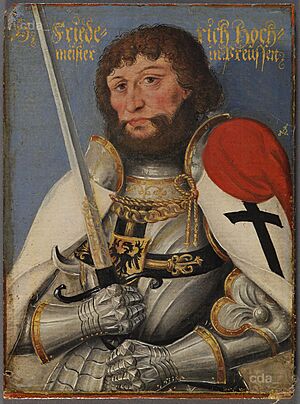Frederick of Saxony (Teutonic Knight) facts for kids
Quick facts for kids Frederick of Saxony |
|
|---|---|

Portrait by Lucas Cranach the Younger
|
|
| Grand Master of the Teutonic Knights | |
| Reign | 1498–1510 |
| Predecessor | Johann von Tiefen |
| Successor | Albert of Brandenburg-Ansbach |
| Born | 26 October 1473 Torgau |
| Died | 14 December 1510 (aged 37) Rochlitz |
| House | House of Wettin |
| Father | Albert III, Duke of Saxony |
| Mother | Sidonie of Poděbrady |
| Religion | Roman Catholic |
Duke Frederick of Saxony (born October 26, 1473 – died December 14, 1510) was an important leader in medieval Europe. He was the 36th Grand Master of the Teutonic Order, a powerful group of knights. He served in this role from 1498 to 1510.
Frederick was the youngest son of Albert III, Duke of Saxony, and Sidonie of Poděbrady. His family, the House of Wettin, was a very important ruling family in Saxony.
Contents
Who Was Duke Frederick of Saxony?
Early Life and Family Connections
Frederick was born in Torgau in 1473. He was part of the Albertine line, which was a branch of the famous House of Wettin. This family ruled over the region of Saxony.
It's easy to confuse him with his cousin, Frederick III, Elector of Saxony, who had the same name. His cousin ruled a different part of Saxony. Frederick's older brother, George, was married to Barbara, who was the sister of King John I Albert of Poland. This family connection would become very important later on.
Becoming the Grand Master
The Teutonic Order was a group of knights who had been fighting for a long time with Poland over control of a region called Prussia. The Order's power had been weakening throughout the 1400s.
They hoped that choosing a leader who had family ties to the Polish royal family, the Jagiellon dynasty, would help them. So, in 1498, the young Duke Frederick was chosen to be their Grand Master.
Challenges and Clever Tactics
When Frederick became Grand Master, King John I Albert of Poland wanted him to perform a special ceremony called "homage." This meant Frederick would have to formally promise loyalty to the Polish king for the lands the Teutonic Order held.
However, Frederick did not want to do this. He took the matter to the Imperial Reichstag, which was a big meeting of leaders in the Holy Roman Empire. The Reichstag told King John I Albert that he could not interfere with the Grand Master's power in Prussia.
Frederick was very good at delaying things. He managed to avoid making the homage for his entire 12 years in office. This was partly helped because three different Polish kings ruled during his time as Grand Master.
End of His Life
Duke Frederick of Saxony died in Rochlitz in 1510. It was a tradition that Grand Masters of the Teutonic Order did not marry. Because of this custom, Frederick never had a wife or children.

